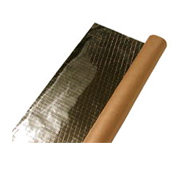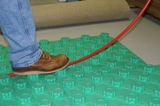Insulation and Reflective Barrier
It is important that the radiant heat goes in the right direction. Since radiant heat will travel in all directions, our insulation and reflective barrier reduce the amount of heat traveling the wrong way.
HOW MUCH INSULATION AND WHAT TYPE?
Concrete projects should have at least 2″ of rigid foam insulation below and on the side edge of the slab. Some energy codes require at least 3″. Be sure to check your local codes for what thickness to use. Radiantec believes that rigid insulation is the best choice for under-slab insulation. It’s designed for below grade applications and has a true and calculable R-value. Some of the thin bubble sheets and barriers that we see on the market claim high r-values. These high R-values are based on reflective properties. So, once you pour concrete over it, you lose the reflective properties and only have the R-value of the material itself.
Joisted projects should use aluminum heat transfer plates and a reflective foil surface below. Then, insulation can be added to the joist bay to further prevent and heat loss downward. The type of insulation doesn’t matter a whole for this installation but the R-value will. You can consult with Radiantec technicians to see how you should insulate below your application.
Showing all 2 results


